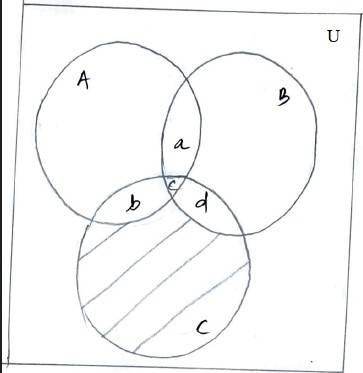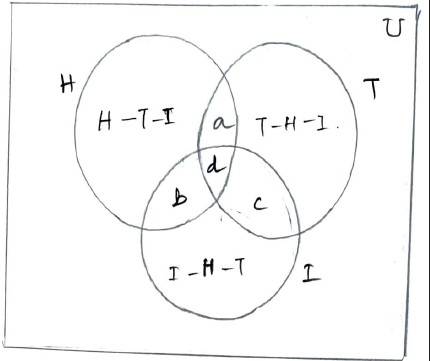Sets
Get insights from 73 questions on Sets, answered by students, alumni, and experts. You may also ask and answer any question you like about Sets
Follow Ask QuestionQuestions
Discussions
Active Users
Followers
New answer posted
2 months agoContributor-Level 9
(|x| - 3)|x + 4| = 6

(-x - 3) (- (x + 4) = 6
(x + 3) (x + 4) = 6 ⇒ x² + 7x + 12 = 6 ⇒ x² + 7x + 6 = 0
(x + 1) (x + 6) = 0 ⇒ x = -6 (since x < -4)
Case (ii) -4 ≤ x < 0
(-x - 3) (x + 4) = 6
⇒ -x² - 7x - 12 = 6
⇒ x² + 7x + 18 = 0
The discriminant is D = 7² - 4 (1) (18) = 49 - 72 < 0, so no real solution.
Case (iii) x ≥ 0
(x - 3) (x + 4) = 6
⇒ x² + x - 12 = 6
⇒ x² + x - 18 = 0
x = [-1 ± √ (1² - 4 (1) (-18)] / 2 = [-1 ± √73] / 2
Since x ≥ 0 ⇒ x = (√73 - 1) / 2
Only two solutions.
New answer posted
3 months agoContributor-Level 10
Given n = 2x. 3y. 5z . (i)
On solving we get y = 3, z = 2
So, n = 2x. 33. 52
So that no. of odd divisor = (3 + 1) (2 + 1) = 12
Hence no. of divisors including 1 = 12
New answer posted
3 months agoContributor-Level 10
Let A = {a, b, c}, B = {1, 2, 3, 4, 5} n (A * B) = 15
x = number of one-one functions from A to B.
y = number of one-one functions for A to (A * B)
New answer posted
6 months agoContributor-Level 10
66. Given series is 1* 2* 3 + 2* 3 *4 + 3* 4 *5 + … to n term
an = (nth term of A. P. 1, 2, 3, …) ´* (nth terms of A. P. 2, 3, 4) *
i e, a = 1, d = 2- 1 = 1i e, a = 2, d = 3- 2 = 1
(nth term of A. P. 3, 4, 5)
i e, a = 3, d = 3 -4 = 1.
= [1 + (n -1) 1] *[2 + (n -1):1]* [3 + (n- 1) 1]
= (1 + n -1)*(2 + n -1)*(3 + n -1)
= n (n + 1)(n + 2)
= n(n2 + 2n + n + 2)
=n3 + 2n2 + 2n.
Sn = ∑n3 + 3 ∑n2 + 2 ∑n
=
=
New answer posted
6 months agoContributor-Level 10
64. Let A, B and C be the set of people who like product A, B and C respectively.
Then,
Number of people who like product A, n (A) = 21
Number of people who like product B, n (B) = 26
Number of people who like product C, n (C) = 29.
Number of people likes both product A and B, n (AB) = 14
Number of people likes both product A and C, n (AC) = 12
Number of people likes both product B and C, n (BC) = 14.
No. of people who likes all product, n (ABC) = 8

a→n (AB)
b→n (AC)
d→n (BC)
c→n (ABC)
From the above venn diagram we can see that,
Number of people who likes product C only
= n (C) - b - d + c
= n (C) - n (AC) - n (BC) + n (ABC)
= 29 - 12 - 14 +
New answer posted
6 months agoContributor-Level 10
63. Let H, T and I be of people who reads newspaper H, T and I respectively.
Then,
number of people who reads newspaper H, n (H) = 25.
number of people who T, n (T) = 26.
number of people who I, n (I) = 26
number of people who both H and T, n (HI) = 9
number of people who both H and T, n (H T) = 11
number of people who both T and I, n (TI) = 8
number of people who reads all newspaper, n (HTI) = 3.
Total no. of people surveyed = 60
The given sets can be represented by venn diagram

(i) The number of people who reads at least one of the newspaper.
in (H∪TI) = n (H) + n (T) + n (I) n (HT) n (HI) n (TI) + n (HTI)
= 25 + 26 + 26 11 9 8 + 3
= 80 2
Taking an Exam? Selecting a College?
Get authentic answers from experts, students and alumni that you won't find anywhere else
Sign Up on ShikshaOn Shiksha, get access to
- 65k Colleges
- 1.2k Exams
- 679k Reviews
- 1800k Answers
